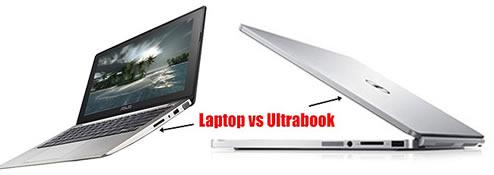Difference between Ultrabook and Laptop
Key Difference: A laptop is a portable personal computer that provides all or most of the features as offered by a desktop computer. An Ultrabook is a sleek version of a laptop and can be categorized under the sub-notebooks. A laptop must meet the specifications defined by Intel in order to be called an Ultrabook.
A laptop can be simply described as a mobile personal computer. It has more or less same functionality as a desktop. However, a laptop is a light weight and compact version of a desktop, and thus can be taken along while traveling. Laptops are also known as notebooks. The components of a laptop include a screen for display, a keyboard, a track pad or trackball as mouse. Most laptops also come with several I/O ports. Modern laptops are also equipped with a wireless networking adapter that allows the user to access the internet without being bothered about the wires.

Ultrabook refers to a thinner version of a laptop. The credit of introducing this term goes to Intel which conceptualized the idea in 2011. The idea of an Ultrabook soon got popularized as it offered a sleek version of a laptop without compromising on other factors like battery, etc. The prominent features of an Ultrabook include-
- Light weight
- Slim body design (sleek)
- Fast processing speed
- Low power consumption
It is important to mention that an ultrabook compromises on features like optical disk drives and Ethernet ports, as these features are omitted to suit the size of the device. Many companies like Samsung, Asus, Toshiba, etc. have started selling Ultrabooks. The price of an Ultrabook is quiet high and that is due to the features it offers to the consumers. A laptop must meet a set of criteria set by Intel in order to be called as an Ultrabook.
Comparison between Ultrabook and Laptop:
|
|
Ultrabook |
Laptop |
|
Definition |
An Ultrabook is a sleek version of a laptop that can be categorized under the sub-notebooks. The name Ultrabook has been given by the company Intel. |
A laptop is a portable personal computer that provides all or most of the features as offered by a desktop computer. |
|
Size |
According to Intel standards a second generation Ultrabook must be less than 0.7 inches thick for laptops with 13.3-inch displays and smaller. (In the 13.3 inch segment most Ultrabooks weigh less than 3 pounds and are up to 18 mm thin)
|
Displays between 10 to 20 inches diagonally, they can weigh anywhere from 2 to 18 pounds. |
|
Keyboards |
Generally better |
Generally shallow |
|
Hardware |
Based on ULV platform |
A range of options |
|
Battery life |
Generally more |
Comparatively less |
|
Price |
Comparatively expensive |
Comparatively cheap |
|
Example |
Acer Aspire Timeline Ultra M-series, Samsung Series 9 |
Lenovo: ThinkPad, Sony: VAIO Sonic F15 |
|
Advantages |
|
|
Image Courtesy: indianexpress.com









Add new comment